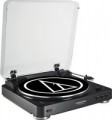Non-removable
The presence of a non-removable pickup in the design of the player.
The pickup (cartridge) is a key part for any turntable; failure of this part renders the entire device unusable. Therefore, non-removable (that is, unsuitable for replacement without disassembly in a workshop) pickups are made mainly in low-cost players, where the manufacturer tries to simplify and, accordingly, reduce the cost of construction. However, even in such models, usually, it is possible to replace the most delicate part of the pickup — the needle.
Model
Model of the pickup (cartridge) supplied with the player. The pickup is one of the most important parts of any vinyl player, the quality of the received sound largely depends on its quality. Knowing the name of the model, you can find detailed data on it and determine how satisfied you are with this particular cartridge.
Needle shape
The shape of the needle in the pickup (cartridge) that the player is equipped with.
—
Conical. It may also be called spherical. The simplest type of needles for vinyl players. Such needles are inexpensive, but the sound quality when using them is relatively low — due to the fact that the shape of the needle rather weakly matches the shape of the groove on the record.
—
Elliptical. Elliptical needles have a narrower shape than conical (spherical) needles, which improves contact and allows, in particular, more accurate reproduction of high frequencies, and also reduces record wear. Due to the good value for money, this option is very popular.
—
Linear. The most advanced variety: sharply sharpened needles of complex shape, following the contours of the grooves on the plate as accurately as possible and having the largest contact area among all types. The downside of this is the complexity in production and, accordingly, the high cost.
Output level
The signal level at the output of the pickup supplied with the player is, in fact, the power of the signal coming from the pickup to the phono stage. This parameter is necessary, first of all, in cases where the player is planned to be connected to an external phono stage: such equipment must be designed for the corresponding power of the signal coming from the pickup.
Downforce
The force of pressing the needle on the plate, which the complete pickup (cartridge) is designed for.
This force depends on the rigidity (compliance) of the needle: the greater the clamping force, the harder the cartridge, respectively, the less pliable it is. It is also believed that less pressing force wears out the record less, but it cannot be said that "light" cartridges are definitely better — there are many other nuances. So in fact, information about the pressing force of a complete pickup is needed mainly in case of its replacement. Usually, the pressing force provided by the arm of the turntable is regulated within these limits, so the new cartridge must also be rated for the same values of downforce — otherwise there is a chance that the turntable will not be able to correctly align.
Tonearm effective length
The effective length of a tonearm in set is the distance from the attachment point (axis of rotation) to the stylus.
This indicator is important primarily for rotary tonearms: the longer the length, the lower the angular error, the smaller the discrepancy between the direction of movement of the track and the longitudinal axis of the pickup (for more details, see “Type”) and the lower the level of corresponding distortion. In addition, a longer length reduces the resonant frequency and reduces the likelihood of distortion. On the other hand, a longer tonearm turns out to be heavier, which requires certain technical tricks and can also negatively affect the purity of the sound. Therefore, a large length is not always a guarantee of high quality – you should also pay attention to weight (see below).
Tonearm weight
Operating weight of the complete tonearm. It is believed that this indicator should be as low as possible — in order not to create excessive pressure and to minimize the wear of the needle and records. On the other hand, a rigid pickup on a light arm can bounce on uneven records, and in general, such a discrepancy does not improve the sound quality. However, complete tonearms are usually optimally compatible with complete pickups; therefore, you should only be interested in compatibility when buying a cartridge of a different model.
Speed control
A method for switching the disc rotation speed provided in the player.
—
Manual. This option is only found on belt driven models (see above). It provides the transfer of the belt to another pulley, due to which the gear ratio and, accordingly, the rotation speed change. This method is not as fast and convenient as automatic, however, it allows you to do without unnecessary electronic circuits (many audiophiles appreciate this feature, because additional electronics can interfere and degrade sound quality).
—
Electronic. Speed switching, carried out by changing the parameters of the electric motor — usually, the user just needs to press a button or move the regulator. This method is much faster and more convenient than mechanical, and for direct drive models (see above) is generally the only possible option. However, the electronics responsible for switching the speed affect the cost of the player and can become a source of additional interference; however, the latter can be compensated by installing control circuits in an external power supply (see below).
External power supply
An external power supply is called a power supply unit (PSU) placed outside the player's case; such a unit can be connected to the outlet with a wire or plugged directly into it using its own plug. The point of this arrangement is to minimize possible interference from the power supply electronics by removing it to the maximum distance from the circuits through which the signal passes. Therefore,
an external power supply is considered the best option for audiophile class acoustics.

